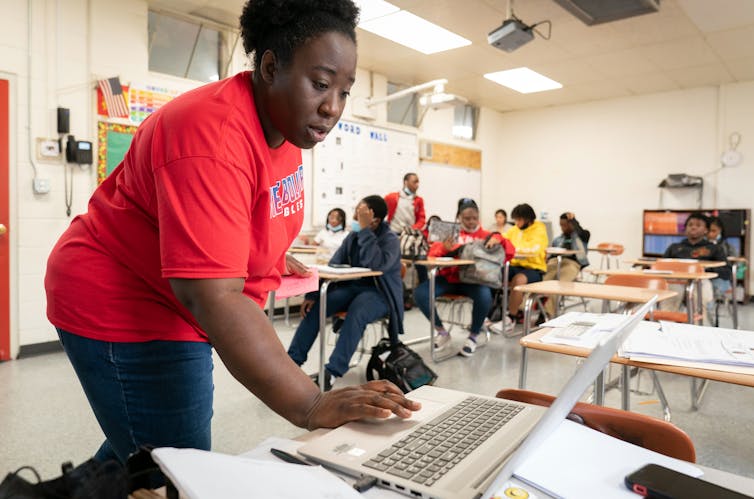Much has been written about the potential consequences of eliminating the Department of Education, one of President-elect Donald Trump’s campaign promises.
Little of the discussion we see focuses on the impact on rural schools, which tend to be more reliant on federal funding than urban schools.
Indeed, rural education often seems to be an afterthought for policymakers and academics, who tend to design reforms aimed at cities and suburbs, even though 20 percent of students nationwide are educated in rural schools.
Due to a lack of rural research and attention, many myths and misconceptions about rural education persist, ignoring the advantages and opportunities for students who attend rural schools.
As scholars who study rural education, we have compiled a list of three facts about rural education, accompanied by some myths, to help policymakers better design programs that support rural students.
1. Rural communities are becoming more diverse
There is a myth that rural communities are overwhelmingly white. While it is true that most rural counties are predominantly white, these communities are becoming increasingly diverse.
According to U.S. Census data, the share of people of color in rural communities increased from 20% in 2010 to 24% in 2020. Additionally, in 10 percent of rural counties, people of color make up the majority of residents.
This is because as white people are leaving, people of color are moving in. From 2010 to 2020, more than 2 million white people left rural communities, and more than 2 million people of color took their place. During the same period, the number of rural people identifying as multiracial doubled to nearly 4 million, and the Latino population increased in all rural communities except Arizona.
Although the black population in rural America has declined in the 2010s, the highest concentration of black people outside cities remains in the rural South. In fact, 81 percent of black people who don’t live in cities live in the South, a legacy of slavery and the reason why generations of Africans were forced to work the land as free labor.
Without a true understanding of the residents of these communities, educators and policymakers cannot adequately address the needs of students. Failure to do so will widen the opportunity gap for rural students, especially those living in the South.

2. Rural educators know how to succeed
Another myth is that rural communities lack the knowledge or resources to successfully educate young people.
As a result, policymakers often fail to incorporate the cultural capital of rural communities when developing textbooks, teacher training programs, and education policies. Cultural capital refers to the knowledge, skills, education, and strengths that people inherit and utilize to succeed in society.
A clear example is that rural communities are rarely represented in teaching materials and courses, which often ignore their local knowledge, traditions and values. This creates a gap in students' ability to see their jobs and positions outside of their personal context. When teachers are not prepared to connect with students’ backgrounds, it hinders teachers’ ability to capitalize on students’ strengths.
State and federal education funding is another example of rural students’ cultural capital being overlooked. Funding policies often penalize smaller rural schools, favor closing and consolidating schools, and ignore their need for more funding to respond to declining local and property tax revenues. This has led to the destruction of the strong social cohesion of rural communities, with buildings abandoned and economic opportunities reduced.
Community initiatives and local plans provide important resources that larger urban areas may take for granted.
The three of us are involved in a new grant program at Michigan State University designed to help change that. The program works to help teachers better engage high school physics and chemistry students and works with two historically black colleges and universities in the rural South to provide more advanced science courses to rural students. By partnering with Alabama A&M University and Winston-Salem State University, it helps ensure the local community's cultural capital is part of the program. It also seeks to unite community partnerships to advance science access and learning in the South.
By redesigning policies to harness rural cultural capital, communities and policymakers can unlock the untapped potential of rural schools and improve educational outcomes for all students, regardless of where they live. We believe that such policies can foster closer connections between rural K-12 public schools and their surrounding communities, creating more relevant and engaging learning experiences for students.
3. Rural students achieve excellent results
The third misconception is that rural students perform poorly. As a result, their academic success is often overlooked by researchers and educators.
In fact, students in rural areas are held to the same standards for success as students in urban areas – especially in the early years. For example, rural schools have higher math and reading scores by third grade than non-rural schools, according to the Center for School and Student Progress. After that, the higher scores start to disappear due to summer learning loss. When schools close for the summer, rural students often have fewer formal summer learning opportunities than students in urban areas. More state and federal funding is urgently needed to expand summer learning opportunities.
Despite widespread learning losses, rural students still graduate at higher rates than non-rural students.
But policymakers have again failed these students, with college enrollment rates lower than in urban areas.
Some of the most common factors contributing to this trend include accessibility, distance between students’ hometowns and colleges and universities, and lower awareness of financial aid opportunities. Additionally, students in the rural South have fewer opportunities than other students to take advanced science courses such as physics and chemistry, which may hinder postsecondary opportunities.
We believe debunking these and other myths and recognizing the diverse strengths of rural communities will help ensure long-term educational and economic success for all students across the country, including those in rural areas.